Shabu-shabu Hotpot: How to Eat and Top 8 Restaurants in Japan

Shabu-shabu is a Japanese dish of thinly sliced meat cooked quickly in a pot of boiling water or broth and served with vegetables, tofu, and noodles. Read on to learn how to enjoy Shabu-shabu and eight of the best restaurant chains in Tokyo and Japan offering this dish.
Shabu-shabu vs. Other Japanese Hotpot Dishes
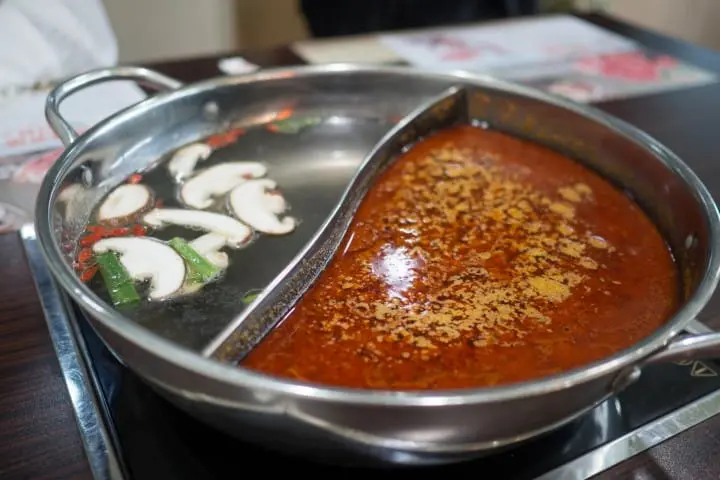
Shabu-shabu is a Japanese dish consisting of thinly sliced meat cooked quickly in a pot of boiling water or broth. The meat is usually beef but can also include pork or seafood. The name "shabu shabu" comes from the sound it makes when the meat is swirled and cooked in the pot.
Shabu-shabu is often served with vegetables, tofu, and noodles, and is accompanied by dipping sauces such as ponzu sauce or sesame sauce. It is often enjoyed in a communal setting where everyone dips their meat and vegetables into the pot to cook, creating a fun and interactive dining experience.
Hotpot dishes (nabemono) usually imply ingredients cooked together in the same pot. However, for Shabu-shabu, you're given plates with raw meat and vegetables; you cook the meat yourself piece by piece by holding it for a few seconds in the boiling broth and enjoy it while it's hot.
Shabu-shabu is also different from Sukiyaki, in which the meat gets cooked in a rich broth seasoned with soy sauce and sugar.
How to Enjoy Shabu-Shabu
1. Main Ingredients in Shabu-shabu
2. How to Eat Shabu-Shabu
3. Final Ingredients: Add Udon Noodles and Other Items
4. Top 8 Shabu-shabu Restaurants in Japan
Nabe-zo
Onyasai
Hanasaka Ji-San
Kagayaki
Shabu Shabu Yamawarau Omotesando
Shabusen Ginza
Matsugen Ebisu
Hokkaido Menkoi-nabe Kumachan Onsen Shibuya Branch
Main Ingredients in Shabu-shabu
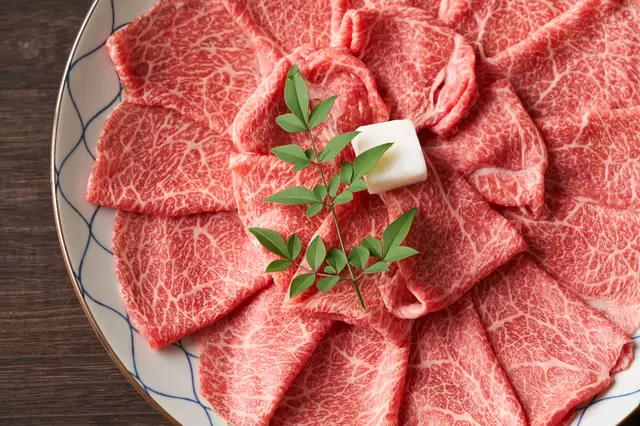
Photo by Pixta
Typically beef is used in shabu-shabu as the centerpiece, but you will also see restaurants with pork and chicken, as well as amberjack, blowfish, octopus, sea bream, snow crab and other seafood.
Fresh vegetables including onions, Chinese cabbage, Japanese radish, carrot, edible chrysanthemum, shiitake and enoki mushrooms, tofu, and other ingredients are all simmered together with the main ingredients.
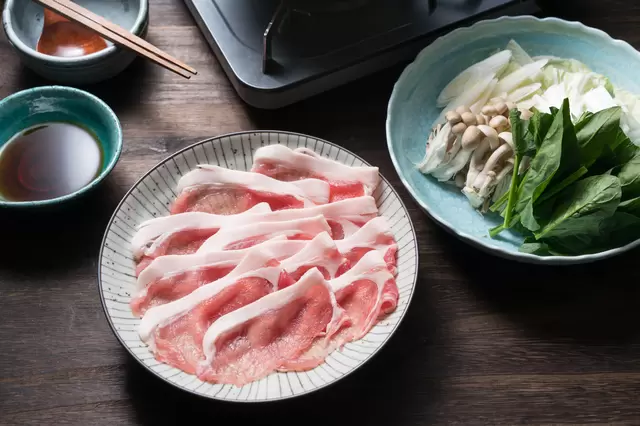
Photo by pixta
If the meat used in shabu-shabu is beef, then it is called gyu-shabu, and if the meat is pork, it is called buta-shabu.
↑ Return to the top of article.
How to Eat Shabu-Shabu

At a shabu-shabu restaurant, a plate of the main ingredient, a hotpot filled with broth from konbu seaweed, and other ingredients are brought to your table. Turn on the burner under the hotpot, and wait for the soup to come to a boil. While you wait, it is a good idea to put your preferred yakumi(*1) and sauce in a saucer.
Shabu-shabu sauces are generally either ponzu(*2) or goma-dare(*3). As for the yakumi, either momiji oroshi (a daikon radish slit open, filled with chili pepper, then grated) or minced onions are popular garnishes. The light pink momiji oroshi and green onions make the food a feast for the eyes.
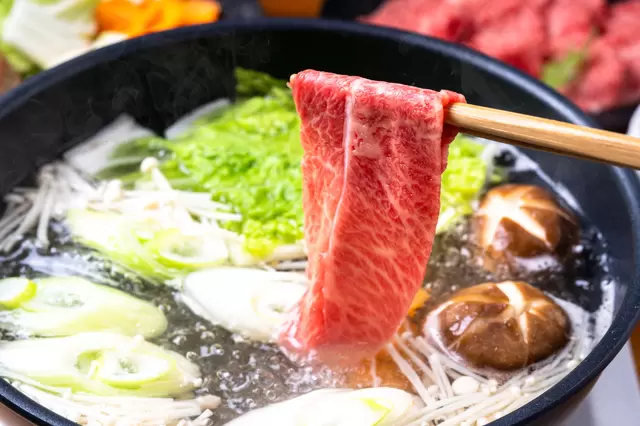
Photo by pixta
Once the soup is boiling, put in the ingredients that do not easily heat all the way through (like onions, daikon radish slices, and tofu). Once it comes to a boil for the second time, take a slice of meat with your chopsticks and swish it around in the soup to heat it, as though you are taking it for a swim. This movement is called "shabu-shabu," and is the reason for the name of the dish.

Photo by pixta
Beef or seafood can be eaten half-cooked once their color starts to change. However, wait for pork to cook all the way through in the soup. While the meat is still hot, dip it in the sauce and yakumi, and enjoy.
*1: Yakumi: A kind of condiment. Often refers to minced onion or grated radish. Used for enhancing flavors, adding color to stimulate appetite, and depending on the situation, for its sterilization properties.
*2: Ponzu: A refreshing condiment, made from vinegar and soy sauce added to juice from Japanese citrus fruit.
*3: Gomadare: A condiment made by mashing sesame seeds made into a paste, then adding soy sauce, vinegar, rice wine vinegar, and sugar.
↑ Return to the top of article.
Final Ingredients: Add Udon Noodles and Other Items
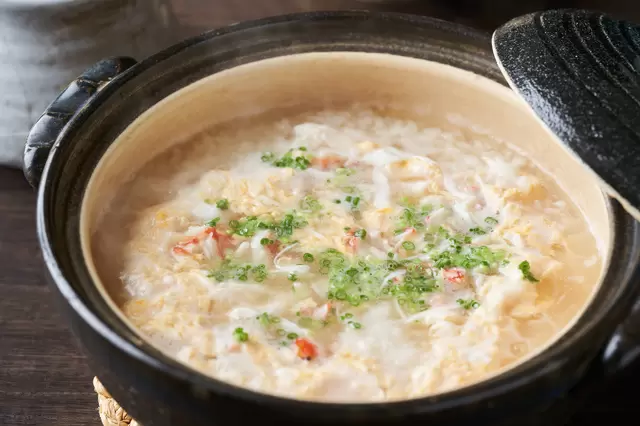
Photo by pixta
For the final ingredients, it is custom to add udon, ramen, or other noodles or rice. This is called "shime" in Japanese, which means "the end." The soup, which has absorbed all the flavors of the ingredients by the end of the meal, will make whatever noodle or rice you add taste very delicious.
The picture above shows cooked rice put it in the soup until it becomes slightly soft, along with a beaten egg cooked until it's half-done. This makes zosui shime, a type of rice porridge.
For noodles, you can usually choose udon or ramen noodles but it depends on the restaurant.
↑ Return to the top of article.
Top 8 Shabu-shabu Restaurants in Japan
There are many restaurants in Japan where you can enjoy shabu-shabu, from small restaurants to chain stores. They often have all-you-can-eat options. Here are three restaurants we recommend for visitors wanting to try this traditional dish.
1. Nabe-zo
Nabe-zo is a restaurant chain with locations in Shinjuku, Shibuya, and other areas in Tokyo, Kanagawa, and Saitama. Diners can choose all-you-can-eat options with beef, pork, and fresh vegetables here for 100 minutes. The restaurant has foreign language support, including English, Korean, and Chinese, so international visitors can feel at ease coming here for a meal. Prices start from around 2,500 yen per person.
Website: https://nabe-zo.com/en
2. Onyasai
Onyasai is a shabu-shabu restaurant with locations across Japan. It is known for having a large menu and is a popular choice of many diners. Guests can choose from pork and beef all-you-can-eat courses that start from around 2,780 yen per person and last for 120 minutes.
Website: https://www.onyasai.com/shp/index.html (Japanese)
3. Hanasaka Ji-San
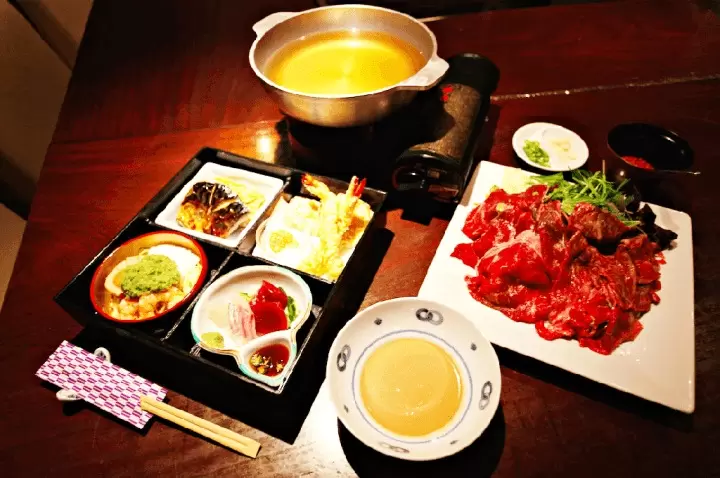
Hanasaka Ji-san is a restaurant in Shibuya, Tokyo that is halal-certified and ideal for Muslim travelers. It specializes in high-quality beef from Miyazaki Prefecture, and also offers other Japanese dishes to diners. This is a restaurant great for a special celebratory night. Prices range from 4,000 yen per person. The restaurant has English support and a website in English.
Website: http://hanasakaji-san.jp/
4. Kagayaki
Kagayaki is a restaurant chain born in Tokushima that specializes in meat dishes. It has two locations in Tokyo: one in Ginza and one near Minowa Station in Asakusa.
Kagayaki is loved for its high-quality meat and extensive vegetable selection, with an impressive variety of mushrooms that never fails to surprise visitors. What sets this establishment apart is its unique pots that allow diners to enjoy both yakiniku (grilled meat) and shabu-shabu.
Website: https://www.kagayakiniku.com/ (Japanese)
5. Shabu Shabu Yamawarau Omotesando
Featuring a counter-style layout, Shabu Shabu Yamawarau Omotesando offers a comfortable space for the solitary enjoyment of shabu-shabu. While suitable for both lunch and dinner, it is particularly recommended for couples or solo diners, ensuring an unforgettable experience.
Website: https://www.flavorworks.co.jp/brand/yamawarau.html
6. Shabusen Ginza
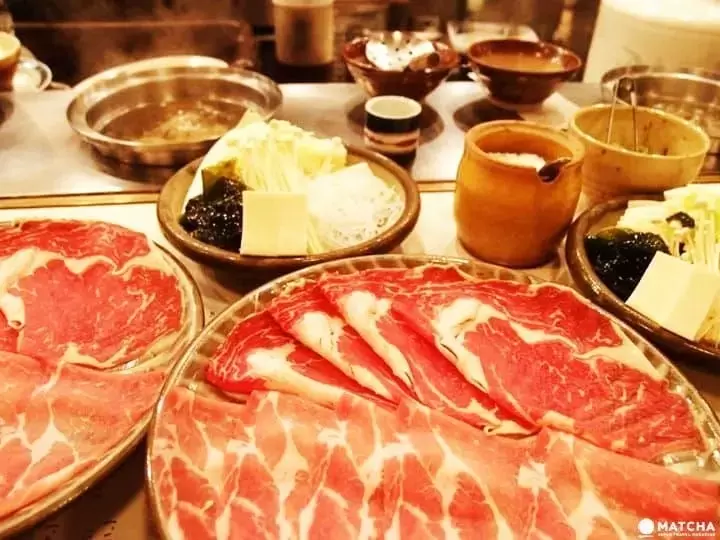
Shabusen is a popular restaurant specializing in Shabu-shabu with stores in Tokyo's Ginza district and Yokohama.
This restaurant is famous for its exquisite goma (sesame seed) sauce made with more than ten different kinds of spices. There's also a light and refreshing ponzu sauce (made from citrus fruit and vinegar) you can try.
Shabusen has gained a wide clientele due to its reasonably priced menu. The Shabu-Shabu Service Lunch or the Kirifuri Kogen Pork Premium (120 grams) can be enjoyed for around 2,000 yen.
Website: https://www.zakuro.co.jp/shabusen/
7. Matsugen Ebisu
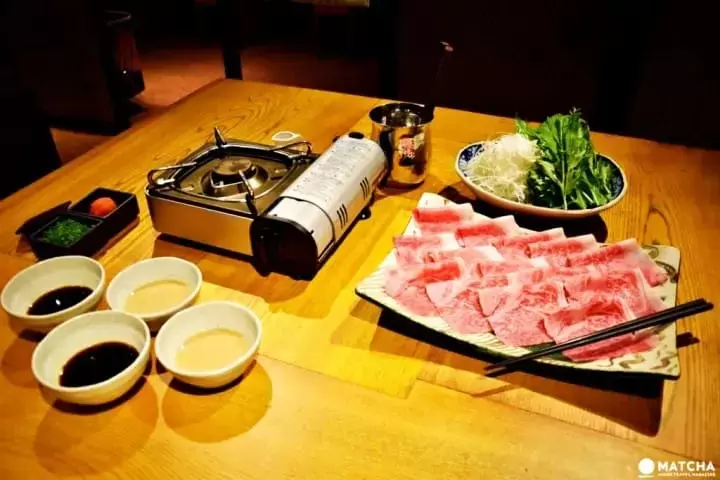
Matsugen is a soba restaurant with branches in Tokyo's Ebisu and Azabu Juban districts. The Ebisu branch also offers shabu-shabu on its evening menu.
The Kinkaton Pork Shabu-Shabu Course is a luxurious course allowing diners to try kKnkaton, a rare and tasty variety of pork. The set comes with extras including sashimi, udon, and even dessert, so you can enjoy trying many different kinds of Japanese food.
Website: https://www.matsugen.net/ (Japanese)
8. Hokkaido Menkoi-nabe Kumachan Onsen - Shibuya Miyamasuzaka Branch
Hokkaido Menkoi-nabe Kumachan Onsen - Shibuya Miyamasuzaka Branch is a renowned chain born in Hokkaido that has gained popularity in Japan. Their distinctive feature is a series of dishes and desserts shaped like a cute bear, Kumachan in Japanese.
Their Shibuya location boasts a stylish interior design coupled with a tranquil atmosphere, making it the ideal setting to indulge in their delightful hotpot dishes.
In addition to Shabu-shabu, they regularly feature special, time-limited hot pot options, providing an array of condiments and dipping sauces for guests to enjoy at their leisure.
Website: https://www.instagram.com/kumachan_onsen_shibuya
Enjoy Shabu-shabu in Japan
Shabu-shabu is a distinctive Japanese dish born out of the love for fresh ingredients cooked on the spot. The Shabu-shabu dishes featuring wagyu beef are especially recommended. Once you try them, you'll probably understand better why hot pot meat dishes are so popular in Japan.
This is the official account of MATCHA's editorial department. Our articles feature useful travel information for visitors to Japan, from how-to guides to recommended places to visit.


































![[2026] Top 5 Strawberry Picking Spots in Tokushima, Naruto| Farms and Access Guide for January to May](https://resources.matcha-jp.com/resize/720x2000/2025/03/06-227165.webp)
![[Yamanashi/ Hokuto City] 4 Hot New Spots Opening in 2026](https://resources.matcha-jp.com/resize/720x2000/2025/12/12-252747.webp)


